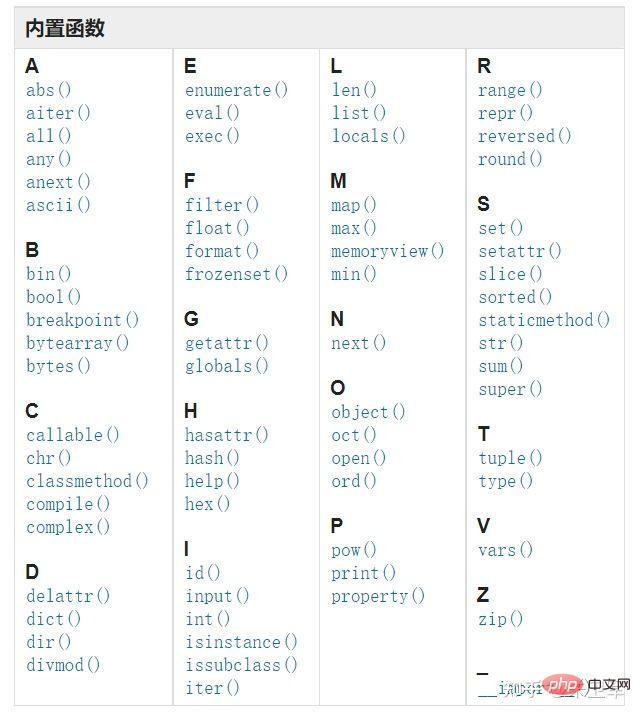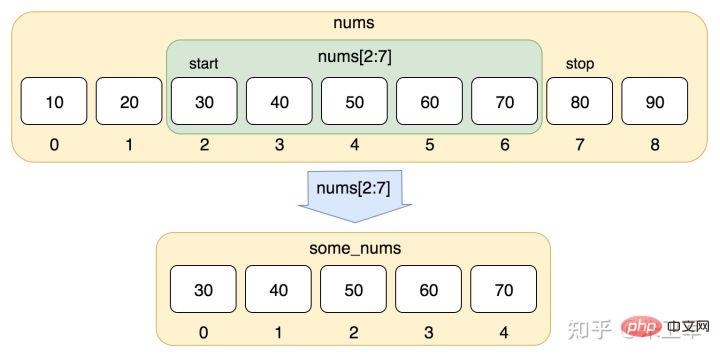파이썬에서 가장 일반적으로 사용되는 명령문과 함수가 무엇인지 이야기해 볼까요?
1. 내장 함수
내장 함수는 zip, filter, isinstance 등 즉시 사용할 수 있는 파이썬 고유의 함수 메소드입니다.

다음은 내장 함수 목록입니다. Python의 공식 문서에 제공된 함수에서는 매우 완벽합니다

다음은 일반적인 내장 함수입니다:
1. enumerate(iterable,start=0)
enumerate()는 Python의 내장 함수입니다. 열거(enumeration)와 열거(enumeration)를 의미합니다.
반복 가능/순회 가능한 개체(예: 목록, 문자열)의 경우 열거는 인덱스와 값을 동시에 얻는 데 사용할 수 있는 인덱스 시퀀스를 형성합니다.
파이썬에서 열거형의 사용법은 대부분 for 루프에서 개수를 가져오는 데 사용됩니다.
seasons = ['Spring', 'Summer', 'Fall', 'Winter'] list(enumerate(seasons)) [(0, 'Spring'), (1, 'Summer'), (2, 'Fall'), (3, 'Winter')] list(enumerate(seasons, start=1)) [(1, 'Spring'), (2, 'Summer'), (3, 'Fall'), (4, 'Winter')]
2.zip(*iterables,strict=False)
zip() 함수는 반복 가능한 개체를 매개 변수로 사용하고 개체의 해당 요소를 튜플로 묶은 다음 튜플 목록을 반환하는 데 사용됩니다.
각 반복자의 요소 수가 일치하지 않는 경우 반환된 목록의 길이는 가장 짧은 개체와 동일합니다. * 연산자를 사용하여 튜플을 목록으로 압축 해제합니다.
zip(iterable1,iterable2, ...).
>>> for item in zip([1, 2, 3], ['sugar', 'spice', 'everything nice']): ... print(item) ... (1, 'sugar') (2, 'spice') (3, 'everything nice')
3.filter(function,iterable)
filter는 시퀀스를 필터링하고 반복자 객체를 반환하며 조건을 충족하지 않는 시퀀스를 제거합니다.
필터(함수, 데이터).
조건 선택 기능으로 작동합니다.
예를 들어, 입력된 숫자가 짝수인지 확인하는 함수를 정의하세요. 숫자가 짝수이면 True를 반환하고, 그렇지 않으면 False를 반환합니다.
def is_even(x): if x % 2 == 0: return True else: return False
그런 다음 필터를 사용하여 목록을 필터링하세요.
l1 = [1, 2, 3, 4, 5] fl = filter(is_even, l1) list(fl)
4. isinstance(object, classinfo)
isinstance는 변수나 개체가 특정 유형에 속하는지 확인하는 데 사용되는 함수입니다.
매개변수 개체가 classinfo의 인스턴스이거나 개체가 classinfo 클래스의 하위 클래스 인스턴스인 경우 True를 반환합니다. object가 지정된 유형의 개체가 아닌 경우 반환 결과는 항상 False입니다.
>>>a = 2 >>> isinstance (a,int) True >>> isinstance (a,str) False >>> isinstance (a,(str,int,list))# 是元组中的一个返回 True True
5.eval(expression[,globals[,locals]])
eval은 문자열 str을 유효한 표현식으로 평가하고 계산 결과를 반환하는 데 사용됩니다.
expression은 전역 및 로컬 사전을 전역 및 로컬 네임스페이스로 사용하여 매개변수 표현식을 구문 분석하고 Python 표현식(기술적으로 조건 목록)으로 평가합니다.
>>>x = 7
>>> eval( '3 * x' )
21
>>> eval('pow(2,2)')
4
>>> eval('2 + 2')
4
>>> n=81
>>> eval("n + 4")
85
자주 사용하는 문장 패턴
일상 코딩 과정에는 실제로 자주 사용되는 문장 패턴이 많이 있는데, 이는 매우 자주 등장하고 흔한 쓰기 방식이기도 합니다.
1. 형식 문자열 형식 지정
형식은 문자열을 템플릿으로 처리하고 전달된 매개 변수를 통해 형식을 지정합니다.
# 格式化字符串
print('{} {}'.format('hello','world'))
# 浮点数
float1 = 563.78453
print("{:5.2f}".format(float1))
2. 문자열 연결
두 문자열을 연결하려면 +를 사용하세요.
string1 = "Linux" string2 = "Hint" joined_string = string1 + string2 print(joined_string)
3. if...else 조건문
Python 조건문은 하나 이상의 문의 실행 결과(True 또는 False)에 따라 실행되는 코드 블록입니다.
if...else 문은 판단이 필요한 상황을 실행하는 데 사용됩니다.
# Assign a numeric value
number = 70
# Check the is more than 70 or not
if (number >= 70):
print("You have passed")
else:
print("You have not passed")
4. for...in, while 루프 문
루프 문은 특정 작업을 수행하기 위해 시퀀스와 루프를 순회하는 것입니다.
for 루프:
# Initialize the list
weekdays = ["Sunday", "Monday", "Tuesday","Wednesday", "Thursday","Friday", "Saturday"]
print("Seven Weekdays are:n")
# Iterate the list using for loop
for day in range(len(weekdays)):
print(weekdays[day])
while 루프:
# Initialize counter
counter = 1
# Iterate the loop 5 times
while counter < 6:
# Print the counter value
print ("The current counter value: %d" % counter)
# Increment the counter
counter = counter + 1
5. 다른 스크립트를 가져오는 가져오기 기능
때로는 다른 Python 파일에서 스크립트를 사용해야 하는 경우가 있습니다. 이는 import 키워드를 사용하여 가져오는 것과 마찬가지로 실제로 매우 간단합니다. 모든 모듈.
vacations.py:
# Initialize values vacation1 = "Summer Vacation" vacation2 = "Winter Vacation"
예를 들어 아래 스크립트에서 위 vacations.py의 코드를 인용하세요.
# Import another python script
import vacations as v
# Initialize the month list
months = ["January", "February", "March", "April", "May", "June",
"July", "August", "September", "October", "November", "December"]
# Initial flag variable to print summer vacation one time
flag = 0
# Iterate the list using for loop
for month in months:
if month == "June" or month == "July":
if flag == 0:
print("Now",v.vacation1)
flag = 1
elif month == "December":
print("Now",v.vacation2)
else:
print("The current month is",month)
6. 목록 이해
Python 목록 이해는 하나 이상의 반복자에서 데이터 유형을 빠르고 간결하게 생성하는 방법으로 긴 구문 코드를 피하고 코드 작동 효율성을 향상시킵니다. 파생을 능숙하게 사용할 수 있다는 것은 간접적으로 Python 초보자의 수준을 넘어섰다는 것을 나타낼 수도 있습니다.
# Create a list of characters using list comprehension
char_list = [ char for char in "linuxhint" ]
print(char_list)
# Define a tuple of websites
websites = ("google.com","yahoo.com", "ask.com", "bing.com")
# Create a list from tuple using list comprehension
site_list = [ site for site in websites ]
print(site_list)
7. 파일 읽기 및 쓰기
계산이 포함된 대화형 Python에 가장 일반적으로 사용되는 시나리오 중 하나는 D 드라이브에서 CSV 파일을 읽은 다음 데이터를 다시 작성하고 저장하는 것입니다. 이를 위해서는 Python이 파일 읽기 및 쓰기 작업을 수행해야 하며, 이는 초보자가 마스터해야 하는 핵심 기술이기도 합니다.
#Assign the filename
filename = "languages.txt"
# Open file for writing
fileHandler = open(filename, "w")
# Add some text
fileHandler.write("Bashn")
fileHandler.write("Pythonn")
fileHandler.write("PHPn")
# Close the file
fileHandler.close()
# Open file for reading
fileHandler = open(filename, "r")
# Read a file line by line
for line in fileHandler:
print(line)
# Close the file
fileHandler.close()
8. 슬라이싱 및 인덱싱
리스트, 문자열, 튜플 등의 시퀀스는 모두 슬라이싱과 인덱싱이 필요합니다. 왜냐하면 데이터를 가로채야 하기 때문입니다. 따라서 이 역시 매우 핵심적인 기술입니다.

var1 = 'Hello World!'
var2 = "zhihu"
print ("var1[0]: ", var1[0])
print ("var2[1:5]: ", var2[1:5])
9、使用函数和类
函数和类是一种封装好的代码块,可以让代码更加简洁、实用、高效、强壮,是python的核心语法之一。
定义和调用函数。
# Define addition function
def addition(number1, number2):
result = number1 + number2
print("Addition result:",result)
# Define area function with return statement
def area(radius):
result = 3.14 * radius * radius
return result
# Call addition function
addition(400, 300)
# Call area function
print("Area of the circle is",area(4))
定义和实例化类。
# Define the class
class Employee:
name = "Mostak Mahmud"
# Define the method
def details(self):
print("Post: Marketing Officer")
print("Department: Sales")
print("Salary: $1000")
# Create the employee object
emp = Employee()
# Print the class variable
print("Name:",emp.name)
# Call the class method
emp.details()
10、错误异常处理
编程过程中难免会遇到错误和异常,所以我们要及时处理它,避免对后续代码造成影响。
所有的标准异常都使用类来实现,都是基类Exception的成员,都从基类Exception继承,而且都在exceptions模块中定义。
Python自动将所有异常名称放在内建命名空间中,所以程序不必导入exceptions模块即可使用异常。一旦引发而且没有捕捉SystemExit异常,程序执行就会终止。
异常的处理过程、如何引发或抛出异常及如何构建自己的异常类都是需要深入理解的。
# Try block
try:
# Take a number
number = int(input("Enter a number: "))
if number % 2 == 0:
print("Number is even")
else:
print("Number is odd")
# Exception block
except (ValueError):
# Print error message
print("Enter a numeric value")
小结
当然Python还有很多有用的函数和方法,需要大家自己去总结,这里抛砖引玉,希望能帮助到需要的小伙伴。
위 내용은 파이썬에서 가장 일반적으로 사용되는 명령문과 함수가 무엇인지 이야기해 볼까요?의 상세 내용입니다. 자세한 내용은 PHP 중국어 웹사이트의 기타 관련 기사를 참조하세요!

핫 AI 도구

Undresser.AI Undress
사실적인 누드 사진을 만들기 위한 AI 기반 앱

AI Clothes Remover
사진에서 옷을 제거하는 온라인 AI 도구입니다.

Undress AI Tool
무료로 이미지를 벗다

Clothoff.io
AI 옷 제거제

AI Hentai Generator
AI Hentai를 무료로 생성하십시오.

인기 기사

뜨거운 도구

메모장++7.3.1
사용하기 쉬운 무료 코드 편집기

SublimeText3 중국어 버전
중국어 버전, 사용하기 매우 쉽습니다.

스튜디오 13.0.1 보내기
강력한 PHP 통합 개발 환경

드림위버 CS6
시각적 웹 개발 도구

SublimeText3 Mac 버전
신 수준의 코드 편집 소프트웨어(SublimeText3)

뜨거운 주제
 7493
7493
 15
15
 1377
1377
 52
52
 77
77
 11
11
 52
52
 19
19
 19
19
 41
41
 MySQL은 지불해야합니다
Apr 08, 2025 pm 05:36 PM
MySQL은 지불해야합니다
Apr 08, 2025 pm 05:36 PM
MySQL에는 무료 커뮤니티 버전과 유료 엔터프라이즈 버전이 있습니다. 커뮤니티 버전은 무료로 사용 및 수정할 수 있지만 지원은 제한되어 있으며 안정성이 낮은 응용 프로그램에 적합하며 기술 기능이 강합니다. Enterprise Edition은 안정적이고 신뢰할 수있는 고성능 데이터베이스가 필요하고 지원 비용을 기꺼이 지불하는 응용 프로그램에 대한 포괄적 인 상업적 지원을 제공합니다. 버전을 선택할 때 고려 된 요소에는 응용 프로그램 중요도, 예산 책정 및 기술 기술이 포함됩니다. 완벽한 옵션은없고 가장 적합한 옵션 만 있으므로 특정 상황에 따라 신중하게 선택해야합니다.
 hadidb : 파이썬의 가볍고 수평 확장 가능한 데이터베이스
Apr 08, 2025 pm 06:12 PM
hadidb : 파이썬의 가볍고 수평 확장 가능한 데이터베이스
Apr 08, 2025 pm 06:12 PM
HADIDB : 가볍고 높은 수준의 확장 가능한 Python 데이터베이스 HadIDB (HADIDB)는 파이썬으로 작성된 경량 데이터베이스이며 확장 수준이 높습니다. PIP 설치를 사용하여 HADIDB 설치 : PIPINSTALLHADIDB 사용자 관리 사용자 만들기 사용자 : createUser () 메소드를 작성하여 새 사용자를 만듭니다. Authentication () 메소드는 사용자의 신원을 인증합니다. Fromhadidb.operationimportuseruser_obj = user ( "admin", "admin") user_obj.
 MongoDB 데이터베이스 비밀번호를 보는 Navicat의 방법
Apr 08, 2025 pm 09:39 PM
MongoDB 데이터베이스 비밀번호를 보는 Navicat의 방법
Apr 08, 2025 pm 09:39 PM
해시 값으로 저장되기 때문에 MongoDB 비밀번호를 Navicat을 통해 직접 보는 것은 불가능합니다. 분실 된 비밀번호 검색 방법 : 1. 비밀번호 재설정; 2. 구성 파일 확인 (해시 값이 포함될 수 있음); 3. 코드를 점검하십시오 (암호 하드 코드 메일).
 MySQL은 인터넷이 필요합니까?
Apr 08, 2025 pm 02:18 PM
MySQL은 인터넷이 필요합니까?
Apr 08, 2025 pm 02:18 PM
MySQL은 기본 데이터 저장 및 관리를위한 네트워크 연결없이 실행할 수 있습니다. 그러나 다른 시스템과의 상호 작용, 원격 액세스 또는 복제 및 클러스터링과 같은 고급 기능을 사용하려면 네트워크 연결이 필요합니다. 또한 보안 측정 (예 : 방화벽), 성능 최적화 (올바른 네트워크 연결 선택) 및 데이터 백업은 인터넷에 연결하는 데 중요합니다.
 MySQL을 해결하는 방법은 로컬 호스트에 연결할 수 없습니다
Apr 08, 2025 pm 02:24 PM
MySQL을 해결하는 방법은 로컬 호스트에 연결할 수 없습니다
Apr 08, 2025 pm 02:24 PM
MySQL 연결은 다음과 같은 이유로 인한 것일 수 있습니다. MySQL 서비스가 시작되지 않았고 방화벽이 연결을 가로 채고 포트 번호가 올바르지 않으며 사용자 이름 또는 비밀번호가 올바르지 않으며 My.cnf의 청취 주소가 부적절하게 구성되어 있습니다. 1. MySQL 서비스가 실행 중인지 확인합니다. 2. MySQL이 포트 3306을들을 수 있도록 방화벽 설정을 조정하십시오. 3. 포트 번호가 실제 포트 번호와 일치하는지 확인하십시오. 4. 사용자 이름과 암호가 올바른지 확인하십시오. 5. my.cnf의 바인드 아드 드레스 설정이 올바른지 확인하십시오.
 MySQL Workbench가 Mariadb에 연결할 수 있습니다
Apr 08, 2025 pm 02:33 PM
MySQL Workbench가 Mariadb에 연결할 수 있습니다
Apr 08, 2025 pm 02:33 PM
MySQL Workbench는 구성이 올바른 경우 MariadB에 연결할 수 있습니다. 먼저 커넥터 유형으로 "mariadb"를 선택하십시오. 연결 구성에서 호스트, 포트, 사용자, 비밀번호 및 데이터베이스를 올바르게 설정하십시오. 연결을 테스트 할 때는 마리아드 브 서비스가 시작되었는지, 사용자 이름과 비밀번호가 올바른지, 포트 번호가 올바른지, 방화벽이 연결을 허용하는지 및 데이터베이스가 존재하는지 여부를 확인하십시오. 고급 사용에서 연결 풀링 기술을 사용하여 성능을 최적화하십시오. 일반적인 오류에는 불충분 한 권한, 네트워크 연결 문제 등이 포함됩니다. 오류를 디버깅 할 때 오류 정보를 신중하게 분석하고 디버깅 도구를 사용하십시오. 네트워크 구성을 최적화하면 성능이 향상 될 수 있습니다
 고로드 애플리케이션의 MySQL 성능을 최적화하는 방법은 무엇입니까?
Apr 08, 2025 pm 06:03 PM
고로드 애플리케이션의 MySQL 성능을 최적화하는 방법은 무엇입니까?
Apr 08, 2025 pm 06:03 PM
MySQL 데이터베이스 성능 최적화 안내서 리소스 집약적 응용 프로그램에서 MySQL 데이터베이스는 중요한 역할을 수행하며 대규모 트랜잭션 관리를 담당합니다. 그러나 응용 프로그램 규모가 확장됨에 따라 데이터베이스 성능 병목 현상은 종종 제약이됩니다. 이 기사는 일련의 효과적인 MySQL 성능 최적화 전략을 탐색하여 응용 프로그램이 고 부하에서 효율적이고 반응이 유지되도록합니다. 실제 사례를 결합하여 인덱싱, 쿼리 최적화, 데이터베이스 설계 및 캐싱과 같은 심층적 인 주요 기술을 설명합니다. 1. 데이터베이스 아키텍처 설계 및 최적화 된 데이터베이스 아키텍처는 MySQL 성능 최적화의 초석입니다. 몇 가지 핵심 원칙은 다음과 같습니다. 올바른 데이터 유형을 선택하고 요구 사항을 충족하는 가장 작은 데이터 유형을 선택하면 저장 공간을 절약 할 수있을뿐만 아니라 데이터 처리 속도를 향상시킬 수 있습니다.
 Amazon Athena와 함께 AWS Glue Crawler를 사용하는 방법
Apr 09, 2025 pm 03:09 PM
Amazon Athena와 함께 AWS Glue Crawler를 사용하는 방법
Apr 09, 2025 pm 03:09 PM
데이터 전문가는 다양한 소스에서 많은 양의 데이터를 처리해야합니다. 이것은 데이터 관리 및 분석에 어려움을 겪을 수 있습니다. 다행히도 AWS Glue와 Amazon Athena의 두 가지 AWS 서비스가 도움이 될 수 있습니다.





